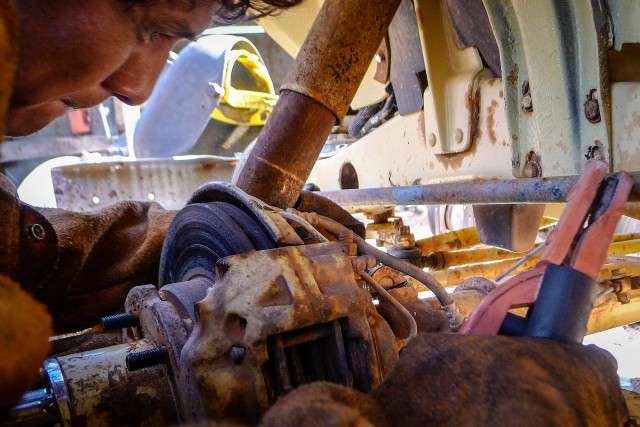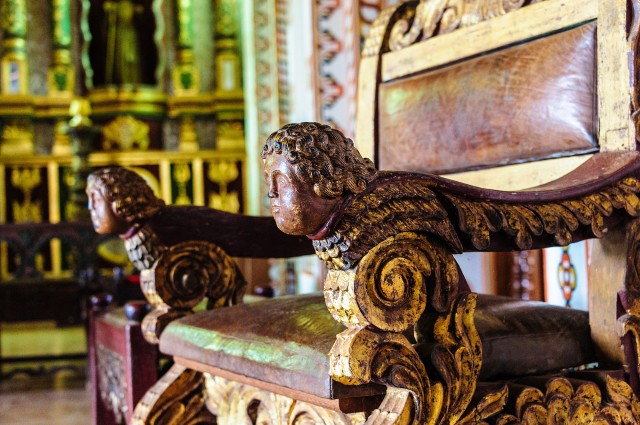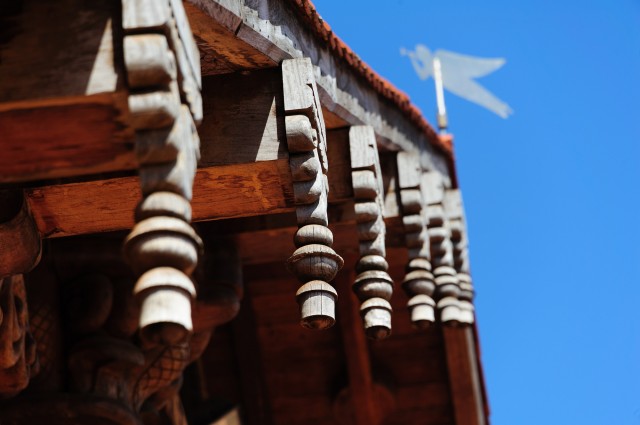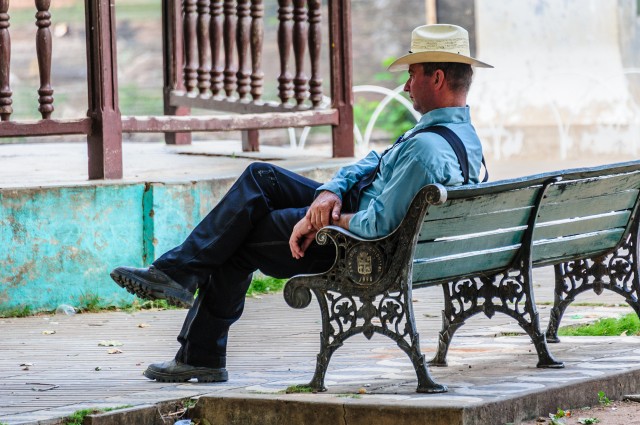Dusty streets lead to the church of San José de los Chiquitos. The baroque-style building lies along the central plaza, together with small, old houses with pillar-supported roofs and shady arcades. Why don’t modern houses have these anymore? The heat here can be as stifling as three centuries ago, the sun piercing your skull just as fiercely while, at other times, rain can drum down just as intensely during the rainy season as in the colonial days. Having porches that cover the pavement just make sense.
While Bolivia is mostly known for its highlands, at least among foreigners, in fact two thirds of the country consists of lowlands and comes with tropical temperatures. You satisfy your sense of adventure in the highlands by driving or cycling the Death Road or Salar de Uyuni. To satisfy your curiosity about Bolivia’s religious life and/or architecture, head for the warmer lowlands and put the Jesuit Missions’ Route on your list.
This doesn’t mean simply crossing a number of churches off your list in a day or two. Driving the Jesuit Missions’ Route does require some stamina: starting at San José de los Chiquitos we’d be covering 250 miles of dirt road plus an additional 125 miles of asphalt to reach Santa Cruz.
The Jesuit Missions in South America
From the 16th to the 18th century, Jesuits built missions, called reducciónes, in north Argentina, Uruguay, Paraguay, south Brazil and east Bolivia. These settlements protected the indigenous people against Bandeirantes, men who hunted the wilderness for gold and/or for people to capture and enslave. In the reducciónes all revenue was shared, everybody was equal, and creating works of art was stimulated. Yet, at the same time, the Jesuits became so wealthy and powerful that they were expelled from South American soil in 1767. Today Bolivia’s former missions are a national heritage and six of them obtained a UNESCO World Heritage Status.
Surviving the heat
The construction of the San José de los Chiquitos is different from the other missions on this route. On the left is the former death chapel where the dead were washed and wakes were held. Today the room serves as a cinema. In the center is the church, next to which stands the bell tower. On the right side are the Jesuit priests’ former living quarters and offices with walls covered in impressive murals.
The church with its thick walls keeps out the paralyzing heat but outside it is infernally hot with temperatures high in the eighties. Everything is dripping with humidity and we feel as if we’re being cooked in a pressure cooker. The Land Cruiser with our precious bottles of drinking water is waiting on the other side of the plaza but having to walk over there feels as exhausting as having to run a marathon. The caretaker sees our need and, with a smile, offers us a bottle of fabulously cold water.
Feeling refreshed we hit the dusty road again. Outside town we come across a tollbooth. To Coen’s question how the toll system works, the women reply that they are no tourist information center but only collect toll fees. We pay 10 bolivianos and continue north. The red road varies from potholed to pretty smooth, and cuts straight through a vastness of green vegetation. Alongside the road workers clad in yellow protective gear are mowing the three-meter-wide verges with machetes. Now they must be sweating!
Fortunately, the road slowly goes uphill. At an altitude of 300 meters the heat is less intense and we camp for the night in the field of a farmer. When Coen opens the hood to help cool down the engine, he notices that the recently bought battery does not agree with the vibrations on the unpaved road and has leaked. This Land Cruiser is incapable of driving 1000 miles without causing some sort of headache so, while annoyed, we are not surprised.
Simple churches, proud people
Next on the list is the church of San Rafael, the archangel you can recognize by the fish he is holding in his hand. European influences contributed by the priests blended with local art, which in Bolivia became known as the baroco-mestizo style. This resulted in churches with carved pillars, murals depicting flowers and animals, and polychrome altars, pulpits and sculptures.
Not all churches are the same, though. This church, like the ones of Santa Ana and San Miguel, has little of the pomp and circumstance that the missions of San Ignacio and Concepción have. And, contrary to San José de los Chiquitos, what’s left of these simple missions consists of one building, the church itself. In the sacristy we meet Nelly, the caretaker. She loves her church and her work here. She tells me how the Chiquitanos were losing their language, which their grandparents still spoke, until in 2009 President Morales changed the constitution, stating that apart from Spanish all 28 indigenous languages now were national languages. As a result Chiquitana is taught in schools again. Not everybody is happy with this, but Nelly sees it as necessity to help keep the culture alive.
In Santa Ana we meet another proud caretaker, Flora. “Santa Ana is the simplest church in terms of architecture,” she remarks. The church was constructed only after the Jesuits were expelled. It is indeed the most rustic one of all, with the once earthen floor now covered in simple tiles and the only glitter coming from an abundance of mica used for the side altars. Flora suggests not retracing the 15 miles to the main road but taking a shortcut to San Miguel. The winding, crude track through thick vegetation doesn’t save us any time but is beautiful with grasshoppers and walking- sticks clinging to the windshield or jumping into our lap through the open window.
Kind and helpful Chiquitanos
We enter San Miguel on a road that is terribly rutted and littered with garbage and quite a contrast to the clean villages we visited earlier. It must be a terrible, dirty mess here when it rains. The walls of the roadside restaurants, once yellow, have a somewhat grayish color with chipped off parts where tables have been shoved against the plastered walls. In many of Bolivia’s basic restaurants you can choose between two set meals. Today the options are costilla frita (which we ate yesterday) and milanesa. I ask if I can have the meat without the milanesa, if the owner understands what I mean. Of course she does and I get the meat fried without the batter and two fried eggs instead. What a service.
We like the Chiquitanos; these past two days we have met many friendly people. When driving and watching life along the road we have noticed how many people smile or laugh. I guess in all their simplicity people are enjoying themselves here. Are happy. And that is always nice to see.
By late afternoon we have visited four churches. That will do for the day. We need a rest and stop at a lake where locals are taking a swim. In many countries women don’t wear bathing suits but swim in their clothes, including Bolivians. Since we get enough stares as it is I always adapt, no matter how I hate swimming like this (let alone afterwards changing in our mini-sized Land Cruiser). It’s too hot to bother me today. In the evening three men walk over for chat, sharing their rum-cola with us. When they are gone and we have just closed our eyes, I wake up again.
“Amigo, Amigo.” It takes a while before I realize somebody is calling us. I carefully wake Coen. The drunken man wants money, then a cigarette, then to sell a fish. Coen is polite as ever and at last he leaves.
The last stretch
Off we go again, driving another 90 miles of red earth passing rural life. Chickens, dogs, cows, horses, and donkeys share the road. Women carry laundry on their heads, people live in adobe houses with thatched roofs. Kids run around, laughing, and the elderly hang around on their verandas. We pass cemeteries with plain wooden crosses. The road comes with additional washboard and potholes, but the summits offer vast views.
In Concepcion Coen notices a shock breaker had broken off. We find a workshop that comes with capable mechanics, which, in this country, we consider a lucky shot. Coen wouldn’t have minded staying here longer to get more work done on the Land Cruiser but for once we have an agenda and have to move on. We’d like to camp at another balneario – lake or river suited for bathing – which should be here according to our guidebook. We can’t find it. The sun is setting and all fields are fenced in. As we need a place to sleep we knock on the door of an estancia, asking for permission to camp in a field. No problem at all. In the company of cows and, as it turns out in the morning, a couple of llamas as well, we have a rustic camping spot with toucans calling from a nearby tree.
On the grassy plaza across from the church of San Xavier a man has set up a traditional sugar cane juicer. His horse is led in circles to work the press and for little money we enjoy the sweet drink. One last rustic mission, its walls partly covered in soft-tinged paintings. Here we come across one of our favorite wooden sculptures. One that says that despite all European influences we are in a South American church. Coen calls me over.
“Oh, another St Francis?” I ask, wondering. How special is that after the dozen or so we have seen already. But Coen has an eye for details.
“Look what he is caressing.”
As you may know St Francis is always in the company of animals, often birds. But giant anteaters? That happens only here, in the tropical lowlands of Bolivia. – KMV
Read more adventures from the road by clicking the banner below:





































